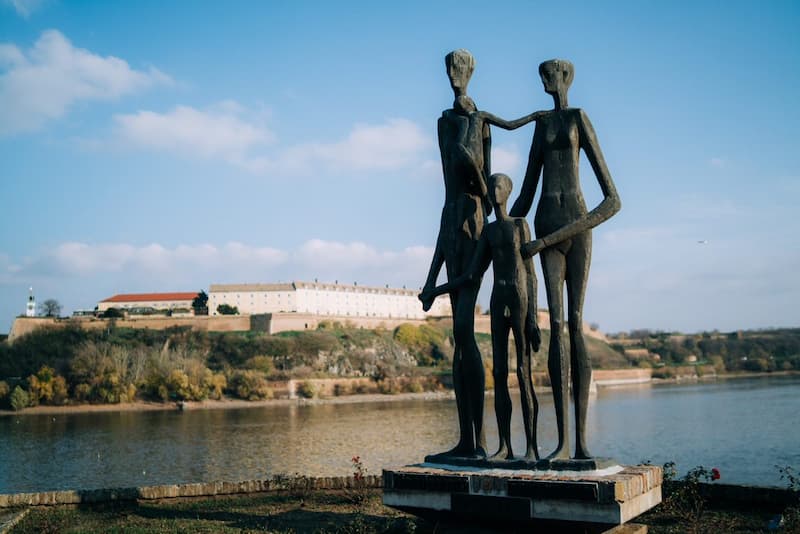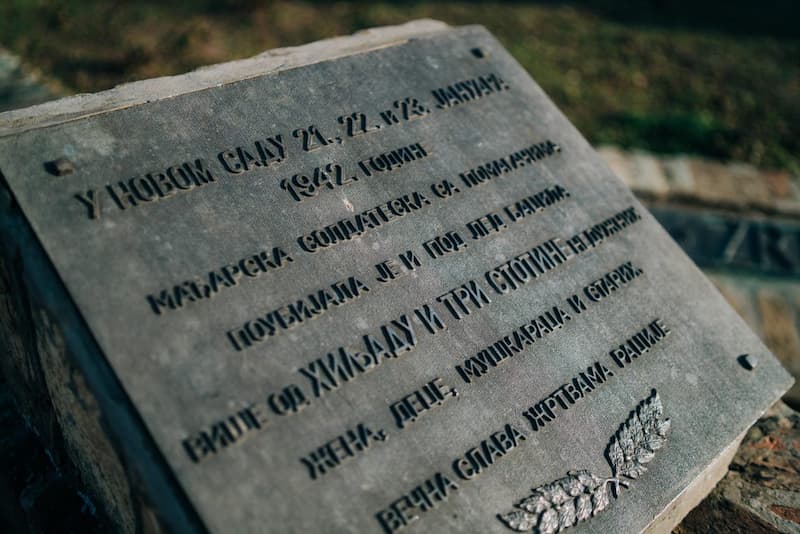Wishing to remember the victims of the brutal ethnic massacre that changed our city 81 years ago, we bring you a historical story about the Novi Sad Raid.
The Bačka Pogrom and the Novi Sad Raid – Unprecedented Crimes of Ethnic Cleansing
In the midst of World War II, in the winter of 1942, Hungarian fascists committed a heinous crime against Serbs, Jews and Roma in southern Bačka. This event is known as the Bačka Pogrom, and its culmination is the Novi Sad Raid, from 21 to 23 January 1942. The killings in Bačka started on 4th and lasted until the 29th of January. The real goal of the raid was an ethnic cleansing campaign in Bačka, aimed at Serbian and Jewish civilians (including women, children and the elderly), as well as looting of property.
This crime was planned much earlier by the highest military-police officials of the then fascist Hungary. The raid in southern Bačka is, in a way, the culmination of the policy of revanschism and revisionism, for which Horthy’s Hungary was preparing after the World War I and applied it on the territory of the ‘returned lands’, i.e. Bačka. At the beginning of January 1942, German Foreign Minister Joachim von Ribbentrop visited Budapest, followed by Field Marshal Wilhelm Keitel, Chief of the Supreme Command of the Wehrmacht. It was requested that the entire Hungarian royal army be transferred to the Eastern Front. Hungarian Prime Minister László Bárdossyi refused, justifying his decision with the alleged danger of a large partisan uprising in Bačka.
The alleged reason for the large-scale pogrom was found in the discovered Šajkaš Partisan Unit in Žabaljski rit, on Pustajić farm. The unit was discovered by a patrol of Hungarian gendarmes and border hunters on 4 January, and on the same day, the unit was completely destroyed. This event was declared as an ‘uprising’ and was used as an excuse to carry out the planned genocide. The Hungarian government sends Honvéd from the Szeged garrison, who start looting, burning, killing, and raping.
Brutal Sufferings during the Early Morning at -30 Degrees
The raid started in Šajkaška – Čurug, Žabalj, Gospođinci, Đurđevo, Titel…(4-19 January), continued in Novi Sad (21-23 January), and ended in Bečej (25-29 January). That January, temperatures dropped to 30 degrees below zero. The Novi Sad Raid began on 21 January 1942 around 6 a.m., when the Hungarian Honvéd forces blocked the streets and in order to discover the hidden partisans, they began to conduct a ‘search’. This meant shooting civilians in their backyards, on the streets, at the Uspensko groblje (Assumption Cemetery), on the playground of the NAK (Novi Sad Athletic Club), in the barracks (Laktanjijeva Street), etc. However, most of those arrested were transferred by truck to the city beach Štrand, where holes were cut on the ice and where people were killed by infantry weapons.
Scenes that Make Your Blood Run Cold
Before the execution, people took off their clothes and all their valuables were taken away. The massacres on the banks of the Danube began on 22 January at 4 a.m. and lasted until 4 p.m., and continued the next day. The victims fell into the water, and those who fell to the shore were pushed under the frozen Danube by soldiers. An observer from the other shore found that 15 people were killed per minute. The corpses were thrown into the Danube, on Štrand, near Danubius, near the old railway bridge and near the slaughterhouse. This is what the Novi Sad Raid looked like. In this operation, the army was assisted by the city administration, which removed bloody traces from the place of mass crimes. After a few days, it could be seen that some civilians were coming to the corpses and taking off their clothes, because some bodies were still lying on the ice. When the ice started moving in the spring, corpses sailed along the Danube all the way to Belgrade and further, even to Romania, testifying to the horrific crimes of the occupier and its helpers.

The possibility of robbery was a strong motive for gaining soldiers, but also the local Hungarian population. Soldiers and gendarmes had complete freedom of action during the raid. The most bloodthirsty acts were committed in those homes, where the previous search determined that there were many items of value. Clothes, shoes, jewellery were removed from the corpses… Neighbours, servants and local Hungarians dragged the furniture of the killed families.
The Goal? To Change the Demographics…
The main reasons for this mass killing lay in the planned and continuously developed hatred towards Serbs, incitement to revenge and anti-Semitism. The main goals were to destroy the mentioned peoples by liquidating their intelligentsia, and to gain enormous material benefits by killing the merchants, craftsmen and rich farmers. It is quite certain that almost all the victims in the raid were killed on the basis of previously precisely compiled lists. The Hungarian occupier had the goal of changing the ethnic composition of the population of Bačka, and that is why the main victims were Serbs and Jews.
Raid or… Genocide?
The total number of those killed will never be determined exactly, because entire families were thrown under the ice of the Danube and the Tisa, leaving no living witnesses behind. Zvonimir Golubović states that about 4,000 people were killed in Bačka, of which about 500 children, and 1,246 in Novi Sad, which is confirmed by concrete data. The January raid in Bačka in 1942, in which about 4,000 people died, took place in a relatively small territory, over an innocent and completely unprotected population, regardless of gender and age. Based on these facts, we can conclude that the January raid exceeded the scope of mass murders and took on the character of a real genocide.
The Family Lives through Memories
On the Quay of the Victims of the Raid in 1971 a bronze monument was erected, more precisely a composition called ‘Family’. The monument is 4 metres high and is the work of sculptor Jovan Soldatović. In 1992, another 78 bronze plates were placed.

Basic information about the raid was written on four plates in Serbian and Hebrew, and the names of those killed were written on the remaining 66 plates. The plaques are decorated with symbols of the Star of David, the cross and the Serbian cross (ocilo). Below the monument are plaques with texts in Serbian, Hungarian, Slovak and Hebrew. Every year, a series of commemorative programmes in Novi Sad marks the Novi Sad Raid and preserves the memory of all the innocent victims.

Who Is To Blame?
The person who most strongly and loudly condemned the crimes of the Hungarian armed forces in Bačka in Hungary was Endre Bajcsy-Zsilinszky, a prominent politician and member of the Hungarian Parliament, who himself tragically ended in December 1944. After the Second World War, some of the perpetrators of the raid were sentenced to death by the People’s Court in Hungary. Many were tried in Yugoslavia, where they were justly punished. On 1 November 1945, the Military Court of the Third Yugoslav Army in Novi Sad sentenced Géza Bátori and József Kenyeki, PhD, to death by hanging, and Leó Deák, PhD, Milan L. Popović, Gyula Kramer and Gyula Zombori to death by firing squad. By the verdict of the Supreme Court of Vojvodina on 31 October 1946, Ferenc Feketehalmy-Czeydner (public hanging in Žabalj), József Grasi and Márton Zöldi (public hanging in Novi Sad), Ferenc Szombathelyi, Lajos Gál, Ernő Bajsai, Miklós Nagy were sentenced to death. Ferenc Bajor and Pal Perepatić (shooting). Captain of the Hungarian Gendarmerie Sándor Képíró, who was tried in 2011 in Budapest, was acquitted for lack of evidence. He died shortly after the verdict.
Author: Author: Ljiljana Dragosavljević Savin, MA Historian
Photo: Jelena Ivanović







